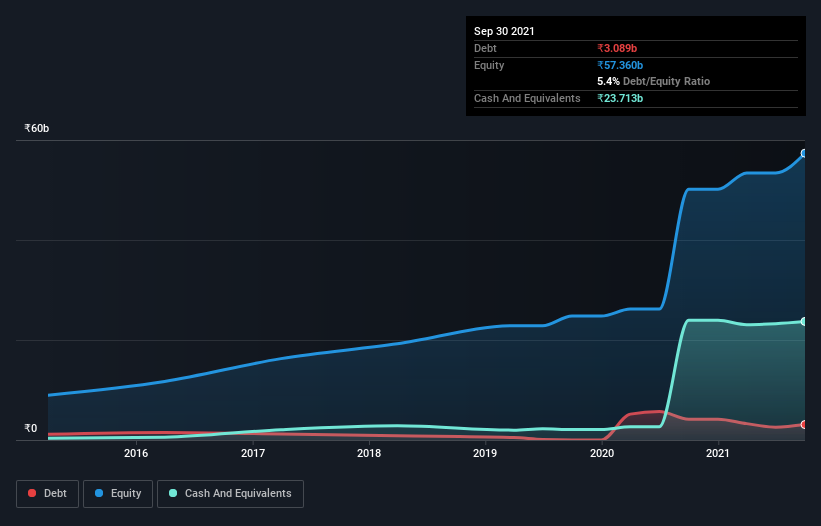Does PI Industries (NSE:PIIND) Have A Healthy Balance Sheet?

Howard Marks put it nicely when he said that, rather than worrying about share price volatility, 'The possibility of permanent loss is the risk I worry about... and every practical investor I know worries about.' So it might be obvious that you need to consider debt, when you think about how risky any given stock is, because too much debt can sink a company. As with many other companies PI Industries Limited (NSE:PIIND) makes use of debt. But should shareholders be worried about its use of debt?
What Risk Does Debt Bring?
Generally speaking, debt only becomes a real problem when a company can't easily pay it off, either by raising capital or with its own cash flow. If things get really bad, the lenders can take control of the business. However, a more frequent (but still costly) occurrence is where a company must issue shares at bargain-basement prices, permanently diluting shareholders, just to shore up its balance sheet. Of course, the upside of debt is that it often represents cheap capital, especially when it replaces dilution in a company with the ability to reinvest at high rates of return. When we examine debt levels, we first consider both cash and debt levels, together.
See our latest analysis for PI Industries
How Much Debt Does PI Industries Carry?
As you can see below, PI Industries had ₹3.09b of debt at September 2021, down from ₹4.16b a year prior. But on the other hand it also has ₹23.7b in cash, leading to a ₹20.6b net cash position.

How Strong Is PI Industries' Balance Sheet?
Zooming in on the latest balance sheet data, we can see that PI Industries had liabilities of ₹14.4b due within 12 months and liabilities of ₹3.59b due beyond that. Offsetting these obligations, it had cash of ₹23.7b as well as receivables valued at ₹9.68b due within 12 months. So it can boast ₹15.4b more liquid assets than total liabilities.
This surplus suggests that PI Industries has a conservative balance sheet, and could probably eliminate its debt without much difficulty. Simply put, the fact that PI Industries has more cash than debt is arguably a good indication that it can manage its debt safely.
And we also note warmly that PI Industries grew its EBIT by 19% last year, making its debt load easier to handle. When analysing debt levels, the balance sheet is the obvious place to start. But ultimately the future profitability of the business will decide if PI Industries can strengthen its balance sheet over time. So if you want to see what the professionals think, you might find this free report on analyst profit forecasts to be interesting.
Finally, a company can only pay off debt with cold hard cash, not accounting profits. PI Industries may have net cash on the balance sheet, but it is still interesting to look at how well the business converts its earnings before interest and tax (EBIT) to free cash flow, because that will influence both its need for, and its capacity to manage debt. Over the last three years, PI Industries reported free cash flow worth 15% of its EBIT, which is really quite low. For us, cash conversion that low sparks a little paranoia about is ability to extinguish debt.
Summing up
While we empathize with investors who find debt concerning, you should keep in mind that PI Industries has net cash of ₹20.6b, as well as more liquid assets than liabilities. And we liked the look of last year's 19% year-on-year EBIT growth. So we are not troubled with PI Industries's debt use. There's no doubt that we learn most about debt from the balance sheet. However, not all investment risk resides within the balance sheet - far from it. Be aware that PI Industries is showing 1 warning sign in our investment analysis , you should know about...
When all is said and done, sometimes its easier to focus on companies that don't even need debt. Readers can access a list of growth stocks with zero net debt 100% free, right now.
New: Manage All Your Stock Portfolios in One Place
We've created the ultimate portfolio companion for stock investors, and it's free.
• Connect an unlimited number of Portfolios and see your total in one currency
• Be alerted to new Warning Signs or Risks via email or mobile
• Track the Fair Value of your stocks
Have feedback on this article? Concerned about the content? Get in touch with us directly. Alternatively, email editorial-team (at) simplywallst.com.
This article by Simply Wall St is general in nature. We provide commentary based on historical data and analyst forecasts only using an unbiased methodology and our articles are not intended to be financial advice. It does not constitute a recommendation to buy or sell any stock, and does not take account of your objectives, or your financial situation. We aim to bring you long-term focused analysis driven by fundamental data. Note that our analysis may not factor in the latest price-sensitive company announcements or qualitative material. Simply Wall St has no position in any stocks mentioned.
About NSEI:PIIND
PI Industries
An agrisciences company, engages in the manufacture and distribution of agrochemicals in India, rest of Asia, North America, Europe, and internationally.
Excellent balance sheet with proven track record and pays a dividend.

